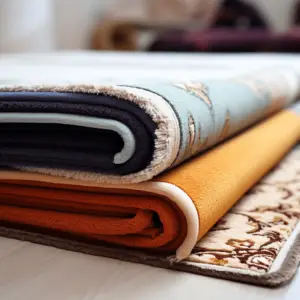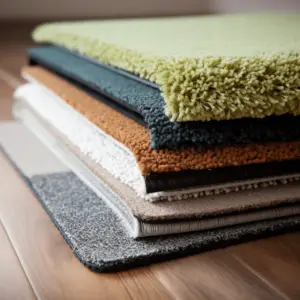Carpet pads serve a variety of functions. First, they add a little extra softness to your carpet. Pads extend the life of your carpet by absorbing the majority of the impact from all of your household’s foot movement. Many pads include an extra layer of protection to keep spills off your flooring. Finally, padding acts as additional insulation for your home, allowing you to save money on your energy expenses.
Table of Contents
6 lb carpet pad vs 8lb carpet pad: What is the Difference?

You are likely to come across two common types of carpet pads in the market; 6 lb carpet pad and 8lb carpet pad. What is the difference between these two types of pads?
A 6-pound carpet pad is softer underfoot, whereas an 8-pound carpet pad is more robust and can help your carpet last longer. For high-traffic areas of your home, an 8-pound carpet pad is also recommended.
Why Should You Select a Carpet Pad with a Density Rating of 6-8 Pounds?
While selecting a residential carpet pad, go for a density rating of 6 to 8 pounds. Carpet padding with a density of less than 6 pounds is commonly utilized in commercial real estate or in flats where the carpet is routinely replaced.
Padding with a density of 6 pounds provides gentler cushioning than padding with 8 pounds. If you want the firmest, sturdiest, and longest-lasting alternative, choose an 8-pound density rating, which is especially useful in high-traffic areas. High-density padding is the most expensive and lowers the possibility of wrinkling your carpet.
What Else Should You Consider When Choosing a Carpet Pad?
Thickness and Warranty
Choose carpet padding that is thick enough to suit your carpet manufacturer’s requirements. Otherwise, your carpet guarantee will be voided. Most home carpet pads are 7/16-inch thick. If you purchase an overly thick carpet pad, you risk creating ugly folds and creases in and beneath the carpeted surface. Padding that is either too thick or too thin will shorten the life of your carpet.
Urethane Foam
If you want a lightweight, inexpensive choice, consider foam padding, often known as polyurethane or urethane padding. The density of polyurethane padding is higher than that of urethane padding, and it lasts longer.
Urethane padding compresses quickly in high-traffic locations and does not hold up well. Urethane padding is generally advised for buildings where the carpet life expectancy is shorter than three years.
Synthetic Materials
It pads are best for tight-weave or looped carpeting. Synthetic cushioning lasts and is dense. Artificial pad rebounded effectively in high-traffic areas, keeping looped carpet designs from straining and wrinkling.
Synthetic pads resist moisture, mold, and mildew, making them the best concrete basement flooring option.
Recycled Padding
Go with rebond carpet padding if you want a feasible, environmentally friendly, and cost-effective choice. Rebond padding is available in various thicknesses and density ratings and is created from recycled urethane foam and other materials.
Rebond padding is a popular type of padding that can be found at most retail and discount carpet retailers. Choose rebond carpet padding for the most durable padding at the most affordable price.
Why Do You Need Carpet Padding?
Carpet padding is required to reap the full benefits of carpeting. It’s not only what makes your carpet comfortable, but it’s also what keeps it looking new.
Carpet padding does more than give a little squish to your stride. In reality, it accomplishes a great deal more. Let’s have a look at some of the benefits of carpet padding:
Extends the Carpet’s Life

Without a carpet pad under it, that thick, sumptuous carpet you bought will wear out quickly. Carpet padding extends the life of your carpet while also improving its appearance. The truth is that carpet installed without a pad does not survive as long as a carpet installed with a pad. This is so because there’s nothing behind it to buffer the shock of ordinary wear and tear.
Offers Comfort
The warmth and softness of the carpet are significant selling elements. The truth is that a carpet pad is essential regardless of how thick or lofty your pile height is to make your carpet as comfy as possible.
The padding in the carpet softens the force of your steps, making it more comfortable to walk on. Its shock-absorbing qualities also aid in reducing walking fatigue.
Enhances Acoustics
Any underlayment is vital since it aids in the improvement of a home’s acoustics. Apartments, condos, and two-level residences all require sound-absorbing materials. Nobody wants to hear other people pounding their feet!
The use of carpet padding has been found in studies to raise impact noise ratings and result in measurable noise reduction.
Thermal Insulation
Last but not least, carpet padding helps to insulate your property. If you reside in a chilly climate, carpet padding will assist keep some of the heat in your home. Carpet padding will also help retain cool air if you live in a hot environment.
Carpet padding’s insulating properties keep your energy cost low and your home well-insulated.
Features of Carpet Pads
All carpet pads are not created equal. Some have added features that make life easier, such as vapor barriers that minimize moisture damage and eco-friendly materials that promote sustainability. Take a look at your alternatives for these useful add-ons!
Eco-Friendly.
While many pads are made of foam, some are constructed of more environmentally friendly materials like recycled plastic bottles. So they’re not only increasing insulation and comfort underfoot, but they’re also keeping rubbish out of landfills. Win-win!
Vapor Barrier
Spills happen, and since foam padding is so absorbent, it can quickly absorb moisture. If you’re not careful, this can result in flooring damage. Fortunately, many carpet pads nowadays include a vapor barrier. Spills and pet accidents won’t penetrate the padding thanks to this protective layer, which can last up to 24 hours in some cases.
Pre-Attached
Carpet rolls are notoriously tricky to install, but with pre-attached padding, half the job is already done for you. Consider a carpet with an already attached pad if you’re looking for carpeting and padding. This will save you time and effort.
